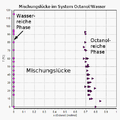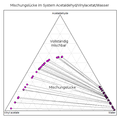Miscibility gap
A miscibility gap designated in a mixture a potential state space , which is characterized in that the mixture of substances not stable in his state has, therefore, the possible states are not realized. A mixture breaks down (segregates) into at least two different phases with very different compositions. The phases are in thermodynamic equilibrium with one another.
Miscibility gap in the liquid phase
The equilibrium of two or more liquid phases is mostly called LLE for engl. Liquid-Liquid Equilibrium.
For example, a decomposes benzene / water mixture into a benzene rich phase, only about 0.3 mole% water is contained within, and is contained in about 0.04 mole% benzene, a water-rich phase; a 1: 1 mix is not possible. On the other hand, some mixtures are completely soluble in one another at some temperatures, while separation takes place at other temperatures (example: methyl vinyl ketone / water).
Most miscibility gaps are T - x - phase diagrams illustrate these different in the case of three substances can also take a triangular shape. The substance mixtures themselves are called mixed phases .
- T, x chart examples of miscibility gaps
Methyl vinyl ketone , water (small miscibility gap in a temperature range)
Octanol , water (water approx. 30 mol% soluble in octanol, octanol almost insoluble in water, x≈0.01 mol%)
Acetaldehyde , vinyl acetate , water; ternary system with marked conodes .
Binodal
→ Main article: Binodal
A miscibility gap is limited by two binodals, the temperature-dependent compositions of the two phases in thermodynamic equilibrium. Binodals can meet at low or high temperatures. This meeting is called (upper and lower) critical solution temperature ( Engl. Upper and lower critical solution temperature , abbreviated UCST and LCST ). The components can be mixed in all proportions above the UCST and below the LCST.
Spinodal
→ Main article: Spinodale
Spinodals are the boundaries within a miscibility gap that delimit a metastable area. The spinodal mostly runs close to the binodal and touches it at the critical point. Compositions within the spinodals are kinetically labile and disintegrate, while in the border area between binodals and spinodals the mixture is metastable .
Konode
A conode connects the equilibrium compositions of the two phases. In diagrams of binary systems these are always horizontal lines and are therefore usually not drawn. Conodes are used to determine the two phases into which a mixture of substances, the composition of which would lie in the miscibility gap, breaks down.
Miscibility gap in solids
Please refer
- Mixed crystals for solids
- Solid solubilities: eutectic , monotectic , peritectic
Miscibility gap in alloys
See alloy .
Individual evidence
- ↑ Entry on upper critical solution temperature . In: IUPAC Compendium of Chemical Terminology (the “Gold Book”) . doi : 10.1351 / goldbook.UT07280 .
See also
- Solutions for liquids




